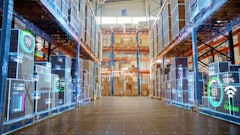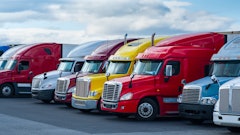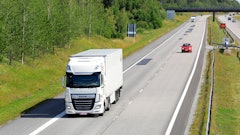With the Wal-Mart mandate looming large in the food industry, radio frequency identification (RFID) is front and center in most food distributors' minds these days. Many suppliers are scrambling to see how they can fit the technology into their day-to-day processes.
The industrial truck industry has also been at work figuring out how the technology can fit into its capabilities. Several companies have announced efforts to tie RFID into their trucks and others are hot on their heels.
Putting RFID to work on lift trucks is just one of the many ways in which the industrial truck industry is beefing up its vehicles. Manufacturers have added a wide variety of truck enhancements that improve performance and make the trucks more comfortable for operators.
Improved Performance
With a healthy number of industrial truck suppliers out there, the variety of trucks available is sure to guarantee that there's a truck for every application. This carries over into recently added features as well, where the breadth of enhancements is wide.
Most of the manufacturers get their ideas for these new features from actual end users out in the field. This has been the case at Cat Lift Trucks, based in Houston. "We design prototypes and take them to customer sites," says Nick Adams, product marketing manager. "We ask operators to try them out and give us feedback. Then we apply the results."
Among some of the latest features added to trucks is an attention to detail. New Bremen, OH-based Crown Equip'ment Corp., for instance, has focused efforts of late on truck accessories. "It's the small items and details that make the operator's job easier," says Jim Blanchard, marketing product manager. "For in'stance, we've added a new steel tube for mounting RF terminals. This puts the terminal out of the operator's visual field and it makes the operator more productive at the same time."
Other small touches on Crown trucks include additional storage areas, fans for operator comfort and mounted clip boards. "We send our designers out into the field," says Blanchard, "and what we've learned is that many users were fabricating things like these. So we look for ways to help the users by adding features they want and need."
Manufacturers have also focused ef'forts on improving the operator interface. "This is key because it makes operators more efficient," says John Colborn, marketing director at Raymond Corp., Greene, NY. "In many food operations, trucks are running 24/7. It gets expensive if you have inefficient operators."
The Raymond reach truck, for in'stance, now has single-access control, making the trucks less tiring to operate. There is also a new, information-based display. "This gives operators information like the date and time of the last battery change and the weight on the forks," Colborn explains. "It's a large display that is easy to read and it makes the operator more capable."
Another design change of late on Raymond trucks has been the addition of a more adjustable cab, including the control handle set up. "This makes the cab more user friendly to a variety of sizes of operators as the demographics of DC employees continues to change," says Colborn.
Irvine, CA-based Toyota Material Handling USA Inc. has also put design efforts into its control unit. "We've installed a three-position handle to suit all heights of operators," says Adam Hughes, material warehouse products manager. "The handle was designed with ergonomic comfort in mind."
Hyster Co., Greenville, NC, has added a new line of counterbalanced trucks with a new transmission system. Some of the new features included in the trucks include new clutch pack designs with improved cooling characteristics to maximize operation, reduce cycle times and maximize up-time, according to Geoff Beale, sales director at the company. "The trucks also offer state-of-the-art engine options and electro-hydraulic controls with either cowl-mounted or seat-side controls," he says. "Our focus was on ease of service, operator comfort and lowest cost of operation."
Overall cost of ownership is what drives truck features at Cat, according to Adams. "The food industry is very competitive and so companies must be cost efficient and productive," he says. "We design around that so that users get the lowest cost of production."
Cat recently introduced the industry's first all-AC reach truck, which includes AC-driven lift functions, steering and travel. "The truck is fully programmable, so operators can program in lifting speeds and adjust the reach mechanism and steering. If a user needs to travel full speed and a long distance, he can program the truck accordingly."
Design Details
At Nissan Forklift Corp., Marengo, IL, design enhancements have culminated in an electronic coast control feature called "click-n-coast" for its end control walkie/rider pallet trucks. "This feature will im'prove order picking efficiency for the operator through push button activation of the coast-control feature," says Keith Allman'dinger, director of product support.
Another design enhancement that several manufacturers have added is the availability of triple-length forks, which extend to 144 inches. Crown's new PE 4000 series is among those offering this feature, allowing operators to transport three to six pallets at a time, reducing the number of trips and improving productivity up to 50 percent.
In general, operators are going to find that today's trucks are easier and more efficient to operate than ever before.
Recent design improvements on lift trucks focus on more than just performance. They also include operator comfort, with the philosophy that a more comfortable operator is a more productive operator. "Our new walkie/rider pallet truck was designed to provide exceptional comfort to the operator," says Nissan's Allmandinger. "The rider platform offers a thick cushioned rubber platform mat. The cover design also provides lots of leg space, giving the operator sufficient room to maneuver and control the truck."
Crown has also focused on the floor mat of its pallet trucks. "We spent close to three years designing and testing the mat and getting feedback from users," Blanchard says. "It makes a big difference in operator comfort."
At Hyster, design has also been focused on operator comfort. "We have incorporated state-of-the-art ergonomics to maximize operator comfort and ensure im'proved productivity," says Beale.
A lowered step height that allows easier access and 20 percent more operator floor space are included in the latest Hyster trucks. Other advances include a smaller steering wheel with standard steer knob and improved seat design for enhanced driver comfort.
Colborn says that Raymond has made its trucks' step height eight inches for entering and exiting their equipment. "We wanted to make it close to normal step orientation so that it would be easy to get on and off," he says. "We also designed our trucks to prevent a lot of twisting and contorting."
Cat has added a flexible side stance to its trucks. "This allows the operator to get into better position by standing in position and being able to operator in either direction," says Adams. "We also offer electric power steering, which has high sensitivity."
As lift truck manufacturers look for new ways to improve their trucks and make end users more efficient, they are increasingly looking into alternative fuels such as hydrogen fuel-cell power. Raymond, for instance, has spent the last two years investigating its viability. The company recently debuted a concept truck at ProMat to introduce users to what may soon be a reality.
When adopted in real applications, fuel cells would replace batteries, generating a savings by eliminating battery change-out and enabling longer run times. When exactly the technology might take off, however, is anyone's guess. "The costs must be in line and the infrastructure must be set up," says Colborn.
Cat is also looking into fuel cell technology. "The viability to take the hydrogen and alter it for fuel is there," says Adams. "But right now the cost needs to come down to make it a reality."
Adams estimates that if hydrogen fuel technology can't get below a cost of $3.50 per kilo, it won't be economically viable. Also, in the food industry, the additional issue of how well the technology could work in the freezer must be addressed.
RFID Integration
The other big unknown in the industrial truck industry right now is how RFID can integrate with the vehicles. Raymond has trucks right now in a working RFID warehouse in Canada. A joint venture with three other North American companies, the project is helping to assess the value, productivity and potential ROI of RIFD in the material handling world.
Raymond says that the benefits of RFID integrated with lift trucks include the fact that operators don't have to dismount or expend effort and time to record receipt, movement or placement of loads. In addition, says the company, RFID codes are highly secure, accurate and flexible.
Cat also has an interest in the technology. "As RFID becomes integral to tracking SKUs, and as the hardware and software becomes cheaper, it will become more common on trucks," says Adams.
Hyster is also looking into ways to incorporate the technology. "As we come out with new truck models, we are combining the latest in operational technology to make them user friendly to RF-type applications," says Beale. "Every customer is different, and as the technology rolls out at more affordable prices for the specific add-on components our customers require, we will see continued growth in this area."
The bottom line is that as new technologies become available, the industrial truck industry will continue to evolve to better serve its customers' needs. "We're not content to rest on our laurels," says Toyota's Hughes. "We're always looking into different forms of technology."



























